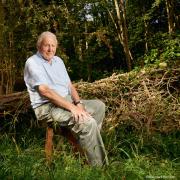Accomplished Brodstairs artist Judith Gardner on bringing her Constable-style landscapes painting to the Garden of England
Kent landscape artist Judith Gardner
Accomplished Brodstairs artist Judith Gardner on bringing her Constable-style landscapes painting to the Garden of England
Judith Gardner is in the first-floor studio of a beautiful Edwardian house, with north-east facing windows, plenty of light, painting landscapes in the style of Constable. The studio has a plain pine chest for storage of paper and work, and on the table in the middle of the room there are pots of brushes of all sizes.
“I’ve always painted. I went to Maidstone School of Art then moved to Windsor because of my husband’s job and taught art at East Berkshire College, both evening classes and to 16-18 year olds,” she tells me.
“I also ran a life class as well as general painting and drawing. I started the Windsor Art Group, as I was there 20 years, and it’s still going.” Last December Judith was made a member of the New English Art Club, a prestigious accomplishment, and she has been a member of the Royal Society of British Artists for 10 years.
Judith has been in Kent for 13 years. “We wanted to move and decided to come to Broadstairs. I do love the sea.” The sea in fact forms part of her main inspiration, together with the landscape and the garden she has created with a particular eye to groupings of plants, flowers and shrubs.
Indeed I first came across Judith’s work in a representation of a bowl of flowers, shown in Oxford, but here in her studio there is testament to that love of landscape too. Not surprisingly, she tells me her artistic heroes are Constable and Turner “and the Impressionists, of course.”
Judith’s skies are pure Impressionism, her fields and hedgerows, Constable. However, she also likes the work of Fred Cuming, another Kent artist and thinks Bath-based artist Peter Brown’s paintings are inspiring.
Art opens your eyes to so many things. You never stop learning
How does Judith prepare for new projects? “My work is really based around seascape and landscape. I go out and look and sketch and I need to know a place very well, so I photograph, I draw and I do sketches of the area.
“Some of these are small so I might work a larger painting from a sketch or just a few lines in a sketch book, but I retain a lot, so it can be quite experimental. I’m not a literal painter in the sense that I have to work totally on the spot.”
Judith works on hard board. “I rub it down and prepare the surface. I put one to two coats of acrylic gesso, then I tint them with oil paint and I use different tints, mainly a burnt umber, a raw umber, burnt sienna or occasionally I use an Indian red, which is vibrant.
“Then I work in loosely with brushes. I don’t draw anything out, it is very loosely worked and afterwards I draw into it. Even then I might loosen areas of painting back into them using large brushes.”
The work ranges from very small five by 10 inches, and then maybe up to three foot by four foot. Here Judith will sometimes use rags to block in or brushes that are almost as large as decorating brushes. Her medium of choice is oil: “I love the fact that you can move the paint around and it’s a very rich medium. I also like pastels, because they can be used in a very similar way to oils, you can use them dry or wet, they’re useful for sketching, and if you’re going away they’re not heavy.”
I asked Judith what her most exciting piece of work has been. “Gosh, that’s difficult. I think probably hop fields. It was a breakthrough, quite a large painting. But I have also done some paintings of the snow and they are very exciting.” A small snowscene sites near us as we talk. “Atmosphere is very important, as well as time of day. I love painting in the mist.”
How important is formal artistic education in Judith’s opinion? “It’s not always important,” she says. “I think people are very strong-willed, they teach themselves a lot and if they are in company with other painters, they can learn a lot. You can also learn by doing your painting.”
The most important attribute for a painter is determination: “You’ve got to have a lot of stamina. You need to look, observe. These are the main things.”
And art is very important. “I think it opens your eyes to so many things. You never stop learning: people I teach say they start to look in different ways, in depth, which people who don’t paint and draw don’t do.”
GET IN TOUCH
Judith Gardner’s work will be on show at the Horsebridge in Whitstable in August and September 2011.
Horsebridge Arts and Community Centre, Whitstable CT5 1AF, tel: 01227 281174
For more information about Judith Gardner tel: 01843 863498


























